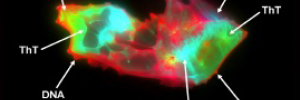
Microscope image of a microclot found in the blood of a person with Long COVID (enlarged 63 times). The green areas show an abnormal, sticky protein network, while the red and blue areas come from immune cellular material that has become trapped inside the microclot. Together, they form dense clumps that may block tiny blood vessels and reduce oxygen flow, a process thought to play a role in the ongoing symptoms seen in Long COVID.
Scientists reveal another piece in Long COVID puzzle
- New study reveals a structural association between circulating microclots and neutrophil extracellular traps (NETs) in patients with Long COVID.
- When dysregulated, this interaction may become pathogenic.
- The study paves the way for the development of novel biomarkers for diagnosis and management of inflammatory and thrombotic diseases.
In patients with Long COVID, a new study has revealed structural association between circulating microclots and neutrophil extracellular traps (NETs).
This finding suggests the existence of underlying physiological interactions between microclots and NETS that, when dysregulated, may become pathogenic.
What are microclots?
The term microclots, recently adopted in the scientific literature, refers to abnormal clumps of blood clotting proteins circulating in a patient’s blood stream. The concept was introduced in 2021 by Prof Resia Pretorius from Stellenbosch University’s Department of Physiological Sciences, when they found the abnormal presence of such microclots in the blood samples of COVID-19 patients. This discovery generated widespread attention during the pandemic due to its potential role in COVID-related coagulopathies.
What are neutrophil extracellular traps (NETs)?
Dr Alain Thierry’s team at the Montpellier Cancer Institute (IRCM) at INSERM in Montpellier, was among the first to identify the critical role of NETs in the pathogenesis of COVID-19. NETs are produced through a specialised form of innate immune response known as NETosis, whereby neutrophils expel their DNA to form filamentous structures embedded with cytotoxic enzymes capable of rapidly trapping and neutralizing pathogens.
However, excessive NETs formation can become detrimental, contributing to a wide range of inflammatory and thrombotic diseases, including severe infections, autoimmune disorders, cancer, diabetes, and arthritis.
According to Dr Thierry, it may be that persistent overproduction of NETs, fueled by self-perpetuating inflammatory and thrombotic loops, exacerbates disease severity.
In a collaborative effort, the teams of Prof Pretorius and Dr. Thierry investigated the potential interaction between microclots and NETs in the context of Long COVID.
Key findings
Using imaging flow cytometry and fluorescence microscopy, they performed a quantitative and structural analysis of microclots and NETs in the plasma of Long COVID patients, compared to healthy controls. NETs were also quantified by analyzing NETs proteic markers and circulating DNA.
- They observed a significant increase in biomarkers associated with both microclots and NETs in patient samples.
- Microclots were not only more abundant but also larger in size among patients.
- Most importantly, they discovered a previously unreported structural association between microclots and NETs, observed in all subjects but markedly more pronounced in Long COVID patients.
“This finding suggests the existence of underlying physiological interactions between microclots and NETs that, when dysregulated, may become pathogenic,” explains Dr Thierry.
Furthermore, the integration of Artificial Intelligence tools, such as machine learning, into the biomarker analysis enabled them to distinguish Long COVID patients from healthy individuals with high accuracy. The algorithms identified the most predictive biomarker combinations, enhancing diagnostic reliability and paving the way for personalized medicine approaches.
According to Prof Pretorius, the results reveal a significant accumulation of microclots in the plasma of Long COVID patients, likely driven and stabilized by excessive NETs production: “This interaction could render microclots more resistant to fibrinolysis, promoting their persistence in circulation and contributing to chronic microvascular complications,” she explains.
By identifying the mechanistic role of NETs in microclot stabilization, this study provides new insight into the pathophysiology of Long COVID. These findings support the development of targeted therapeutic strategies aimed at modulating thrombo-inflammatory responses.
Finally, the study paves the way for the development of novel biomarkers for diagnosis and management: “The combination of advanced imaging techniques and machine learning confers methodological robustness and contributes significantly to the ongoing scientific discourse on post-viral syndromes,” they conclude.
- The paper “Circulating microclots are structurally associated with neutrophil extracellular traps and their amounts are elevated in Long COVID patients” was published in the Journal of Medical Virology and is available online at https://doi.org/10.1002/jmv.70613



